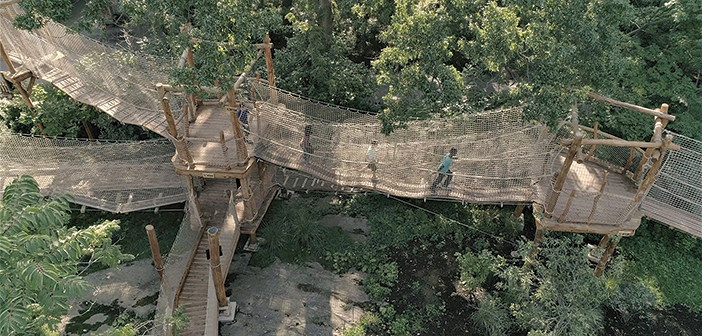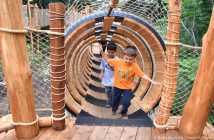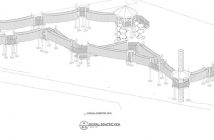As Simon and Garfunkel once sang famously, it’s all happening at the zoo. These days at New York City’s Bronx Zoo, while the pigeons plot in secrecy and hamsters turn on frequently, visitors can have a gas by zip lining or challenging themselves on an adventure course, or ambling along an easy-going nature trek in the trees. That’s all thanks to the award-winning Bronx Zoo Treetop Adventure, designed by Tree-Mendous, that opened this past summer.
Given the diverse audience that frequents the zoo, the park was designed for broad appeal. Inherent in the three-activity design of the adventure park was a goal to include something for everybody. The nature trek is the most accessible of the three components; anyone from small children to seniors and even some disabled people can get in the game.
For those seeking something a little more adventurous, the seven treetop courses range in difficulty from easy to expert, and feature challenges such as suspended bridges, simulated rock climbs, and rope ladders. Taking on the adventure park courses can also be combined with clipping on to the four zip lines, which crisscross the Bronx River, for an extra boost of adrenaline.
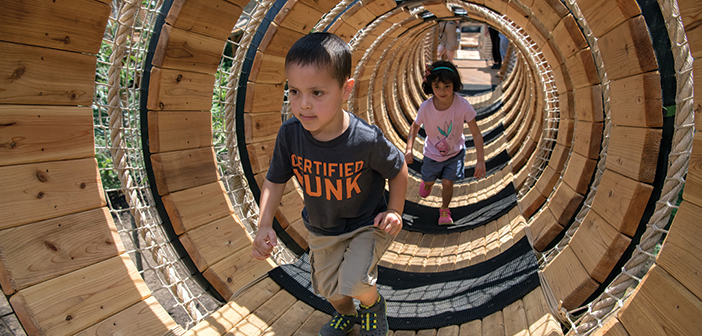
Kids in the tube on the Nature Trek.
The design, construction, and management of the park were enabled by a collaborative approach. Tree-Mendous joined forces with Simex-Iwerks, a media company that was installing a 4D theater in a separate location at the zoo within the same timeframe. While both the theater and the aerial activities might be seen as moving the zoo away from its core business of wildlife viewing, “nobody resisted,” says Chris Filomio, the zoo’s director of rides and parking, and who oversees the new adventure activities. In their own ways, the “wildlife theater” and the aerial park contribute to the zoo’s overall educational, experiential mission.
That mission is in place mainly because the zoo is under the auspices of the Wildlife Conservation Society (WCS), an international non-profit organization dedicated to preserving animals and the natural environment. So, while Tree-Mendous focused on design and construction of all the aerial features, and Simex-Iwerks pitched in with marketing and financing, the on-ground features, with a strong educational component, were the work of WCS. “It’s much more than just a climbing attraction,” says Tree-Mendous owner and founder Gerhard Komenda.
When everything was ready to go, WCS provided the manpower to operate the park, and Simex took charge of equipment maintenance. Training was a shared responsibility, with Tree-Mendous training the aerial staff and WCS handling the nature-education component. Roles appeared to be well defined, so that no one entity was stepping on the feet of another.
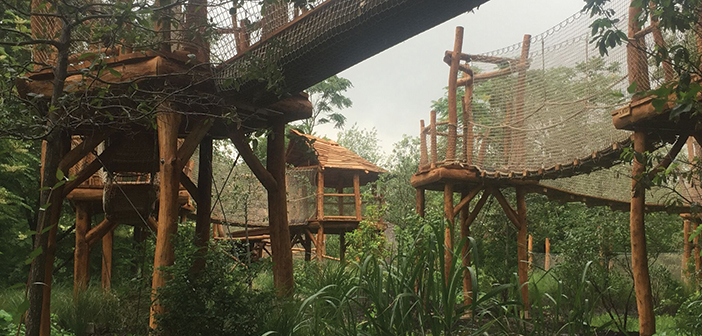
Ground-level view on the Nature Trek walk. This is the Bronx?
The result is a combination of activities that are unique in a city of nine million people, and in an environment unique to the city. To find anything comparable, one must travel an hour or more beyond the metro area. For Tree-Mendous to be able to offer something so rare in a city with so many diverse offerings—New York is, of course, a cultural crossroads of the world—was a special opportunity.
That said, the collaboration is a bit surprising. The focus of the WCS is wildlife and habitat preservation. But when the society’s vice presidents came up with the somewhat out-of-the-box idea to add both the 4D theater and the aerial adventure park, the board of directors unhesitatingly gave its stamp of approval. After all, it was “a new revenue stream to support our mission,” says Filomio.
With the zoo’s annual visitation of approximately 2.1 million, the revenue stream from the aerial park alone could become substantial. Ticket prices for the Treetop Adventure range from $35 to $75. Not only could visitors spend money simply enjoying the zoo activities, they might be inspired to give climbing or zip lining a try. In other words, says Filomio, “great for an upsell from the general admission ticket.” Visitors can purchase adventure park-only tickets, but the zoo also introduced a “total experience” ticket that includes zoo and adventure-park admission. So, even if only two percent of zoo visitors opted for the adventure park, it’ll be a home run.
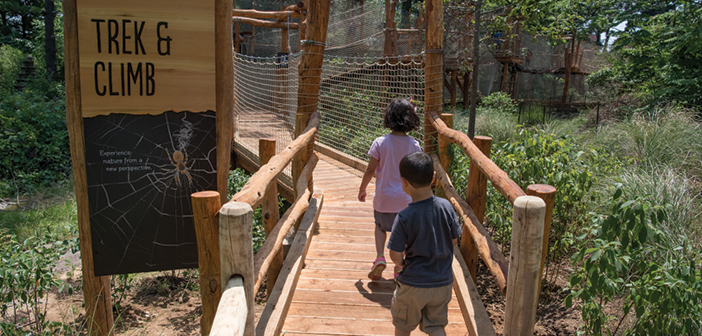
The entrance to the Nature Trek invites kids to experience nature from a new perspective.
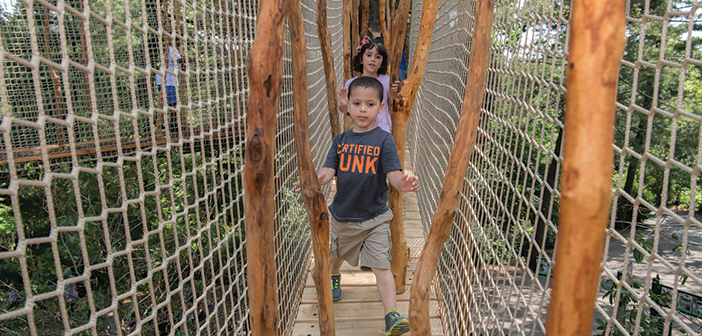
The Nature Trek is designed to suit a wide range of ages.
Navigating the Bureaucracy
The adventure park installation was a particularly sensitive project. Forestland is exceedingly rare within the urban megalopolis that is New York City, so special care was needed to install anything in this forested tract of the Bronx that’s leased by the zoo from the city’s Department of Parks and Recreation. And with education also being a part of WCS’s mission, the aerial park’s design had to incorporate more than simple amusement.
Within that context, Tree-Mendous was a logical choice for the project. Komenda is a forester by trade. He knows trees, and he approached the project with the velvet gloves of a conscientious forest-management expert. Tree-Mendous also had precedent projects in its portfolio, having done similar installations at the San Diego Zoo and on California’s Catalina Island, also under the auspices of a conservancy.
More surprising, perhaps, was how quickly Tree-Mendous, Simex-Iwerks, and WCS were able to get all the necessary approvals from city agencies and others. New York is famous as a city where development projects can become stalled for months and even years in a morass of politics and bureaucracy. Among the agencies with jurisdiction were the Department of Parks and Recreation and the Department of Cultural Affairs. In addition to negotiating with the city, Tree-Mendous, WCS, and Simex-Iwerks had to work with the federal Army Corps of Engineers, because the zip lines crisscrossed the Bronx River. Wetlands impacts had to be considered. Environmental groups such as the Bronx River Alliance also wanted input into the project.

The aerial challenges in the adventure park range from a log bridge to spider nets.
But according to Komenda, it all went “extremely smoothly.” In part, that was because Tree-Mendous, WCS, and Simex-Iwerks were astute in playing the city-politics game. They hired so-called “expediters” to speed the process through NYC agencies, a standard practice in the Big Apple, according to Komenda.
The relative ease of the permitting process, however, didn’t prevent the installation from becoming what Komenda calls “the most hectic project we’ve ever had.” That was largely due to the fact that it was actually three projects wrapped into one: the zip lines, a seven-course adventure installation, and the nature trek.
Hectic as it might have been, Tree-Mendous clearly did something right. After opening in July, the installation earned the prestigious Excellence in Design award from the Public Design Commission of New York City.
While the criteria for the award are vague, certainly a big reason for the installation earning the commission’s recognition was the effort by Tree-Mendous to come up with a design that disturbed the natural environment as little as possible. The idea, says Komenda, was to offer something close to a wilderness experience, “where you can forget you’re in the city.”
Although the installations required some thinning of the canopy and the removal of deadwood and hollow wood, no trees were cut down. All the while, city officials were keeping a careful eye on every twig that was snipped. “It was an immense hurdle to cross,” says Komenda. “New York City is very protective of its trees.”

Dual zip lines crisscross the Bronx River.
Komenda was, too. “Gerhard was looking out for the best interests of the ecology of the trees,” says Filomio. As is his practice, Komenda’s adventure-course features and zip-line terminals were clamped to trees rather than bolted, to lessen scarring and exposure to disease. Except for some tower footings, little was done to disturb the forest floor. According to a Tree-Mendous company philosophy, the idea was that “the health of the forest will improve,” says Komenda.
With the success of the first two months of business, growth plans are already in the works. Komenda gives no details, but says that expansion next year is planned. Also, the installation of lights for night climbing is imminent. Park hours are currently 9-5 (5:30 on weekends); adding evening hours can only help to juice up the revenue stream.
More is happening these days than ever at the Bronx Zoo, and in the near future, even more will be happening. Perhaps it is time for Paul Simon to write a new song.


